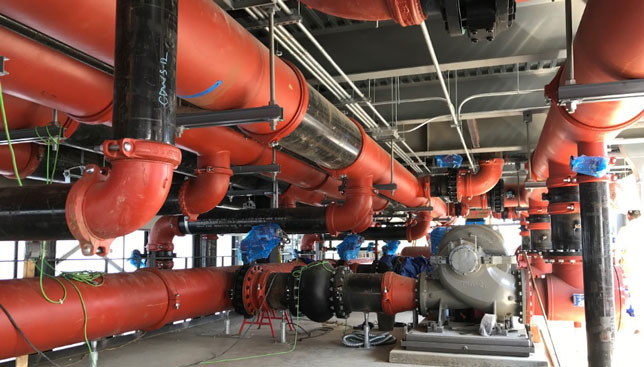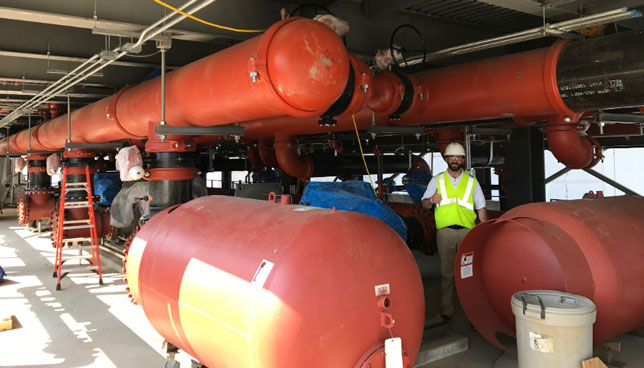Breaking Higher Education's Billion-Dollar Backlog Problem
Strategic mechanical system design can transform campus maintenance backlogs. Here's how.
Across American campuses, facility managers face a stark reality: a staggering $112 billion maintenance backlog threatens the foundational infrastructure of higher education, according to APPA. Unaddressed repairs create deteriorating conditions that force students and faculty to endure uncomfortable learning environments, disrupted operations, and potentially hazardous facilities. This deferred maintenance crisis represents both a challenge and opportunity for facilities professionals. Strategic mechanical system choices can reduce maintenance complexity and minimize downtime to help facilities managers catch up to and regain control over their growing maintenance to-do lists.
The Perfect Maintenance Storm: Staffing Shortages Meet $112 billion Backlog
Skilled labor shortages have dramatically affected daily maintenance operations across higher education institutions. According to NFPA's 2025 Industry Trends survey, 50% of facilities professionals cite qualified worker shortages as their most pressing challenge. This staffing crisis is projected to worsen as experienced personnel retire and institutions struggle with retention. Many institutions haven't returned to pre-pandemic staffing levels due to these shortages, forcing remaining maintenance staff to do more with fewer resources.
Workforce challenges only scratch the surface. Budgetary constraints create difficult choices around which repairs to address first. According to Gordian's 12th Annual State of Facilities in Higher Education report, clearing maintenance backlogs costs facilities $140 per square foot in accumulated repairs — up 2% from 2024. Simultaneously, institutions still face a sizable funding gap of over 32%. The financial pressure has led many institutions to defer all but the most critical repairs, creating a snowball effect that compounds over time.
Unfortunately, when critical systems do fail, the emergency repairs often cost significantly more than preventative maintenance would have. According to research conducted by the Pacific Partners Consulting Group, every $1 in deferred maintenance will cost education facilities $4 in future capital renewal needs. This multiplier effect creates an accelerating deterioration cycle that threatens the foundation of campus operations. The longer maintenance is deferred, the more expensive the eventual repairs become — and the greater the risk of catastrophic failures that can shut down entire buildings or systems. Higher education institutions can break this cycle by investing in strategic design solutions that prioritize maintenance as a mission-critical need rather than a wishlist item. Rather than accepting maintenance challenges as inevitable, forward-thinking institutions are rethinking their mechanical infrastructure to meet both immediate needs and future demands.
How Central Utility Plants Transform Maintenance
It's common to see older campus buildings designed to have their own individual mechanical systems. However, this fragmentation creates inefficiencies and vulnerabilities across campus infrastructure. Transitioning from individual building systems to central utility plants enables higher education institutions to streamline and consolidate maintenance tasks. These systems replace individual boilers and chillers in each building with a single, centralized plant that distributes hot and cold water through campus-wide pipes. These loops simplify the overall system architecture and reduce the number of complex mechanical components across a campus.
Instead of having numerous mechanical rooms with unique configurations, maintenance protocols and equipment requirements that require various specialized skills, central utility plants allow institutions to focus resources and expertise in fewer locations. This significantly reduces the complexity of daily operations and makes maintenance more manageable with existing staff. When specialized knowledge is concentrated in fewer locations, training existing staff to manage centralized systems effectively becomes more feasible. This allows institutions to build teams with deep maintenance expertise rather than requiring broad, generalized knowledge across multiple disparate systems or outsourced labor.
Beyond streamlining maintenance, central utility plants provide significant advantages over individual building systems, including better energy efficiency through economies of scale and built-in equipment redundancy, which improves system reliability. While transitioning to central utility plants represents a significant capital investment, the long-term savings in maintenance efficiency and reduced complexity can offset initial costs through decreased operational expenses and improved system reliability.
Catholic University of America exemplifies this approach. Between 2016 and 2021, the university converted from steam heat to a centralized hot and chilled water system, eliminating the burden of maintaining hundreds of small boilers and pumps scattered across campus buildings. By consolidating operations into a central plant, it significantly reduced maintenance complexity while improving system reliability, allowing its maintenance team to focus on addressing backlogged repairs rather than constantly responding to distributed equipment failures.

A Massachusetts university's central utility plant featuring large distribution piping and tanks. This consolidated system tripled campus cooling capacity with efficient design. (Photo courtesy of Victaulic)
A major state university in Massachusetts took a similar approach when planning for campus growth. A new chiller plant tripled campus cooling capacity with five water-cooled chillers while incorporating innovative redundancy features like a dedicated winter cooling tower for "free-cooling" mode operation. By consolidating previously scattered equipment and designing with maintenance accessibility in mind, the university positioned its maintenance team to better manage existing backlogs while preparing for expanding campus needs.
As these universities have shown, smart design choices make a real difference in tackling maintenance backlogs. By prioritizing accessibility and efficiency from day one, even resource-constrained institutions can escape the endless cycle of deferred maintenance.
 Inside the university's chiller plant showing the comprehensive piping network. This centralized approach replaced scattered equipment across campus, streamlining maintenance operations. (Photo courtesy of Victaulic)
Inside the university's chiller plant showing the comprehensive piping network. This centralized approach replaced scattered equipment across campus, streamlining maintenance operations. (Photo courtesy of Victaulic)
Small Rooms, Big Challenges: Designing for Accessibility
As campuses seek to maximize usable learning space, mechanical rooms are progressively getting smaller, creating significant challenges for maintenance work. These tight spaces make traditional maintenance approaches difficult and potentially hazardous, especially when hot work is required. Equipment layout should allow for complete access to all components needing regular maintenance, with adequate clearance for workers and tools.
Strategic valve placement is essential. Without it, maintenance teams must drain entire systems for minor repairs, creating costly disruptions that can affect dozens of buildings unnecessarily. Systems should be designed to allow teams to isolate specific branches for repairs, keeping the rest of the campus operational and minimizing disruption to critical academic and research activities.
Material Selection for Maintainability
Component selection criteria should focus on reducing long-term maintenance requirements rather than just initial capital costs. For example, traditional vibration attenuation systems — often using rubber bellows or flexible metal hoses — require frequent inspection and replacement. Design teams should evaluate how their product selection contributes to maintenance burden over time, considering the resilience and lifespan of each individual component rather than just the upfront cost of materials.
Strainer baskets on pump systems offer another example where glossing over material selection can directly impact maintenance schedules. Strainer baskets require frequent disassembly for routine cleaning to maintain optimal performance. Flanged strainer baskets with multiple bolts take longer to disassemble and reassemble than their grooved counterparts, which are assembled with couplings which come together with only two bolts, allowing for quicker, easier access. When multiplied across dozens of pumps in heating, cooling, and condenser water systems, these small design choices translate into substantial time savings over the years.
For instance, certain pipe-joining methods such as flanged or grooved allow systems to be easily disassembled and reassembled for maintenance, inspections, and modifications, while other methods such as welding require cutting into pipes, significantly increasing the difficulty and time required for these tasks. When maintenance teams can quickly access, inspect, and reassemble components throughout the system, preventative maintenance becomes more manageable and cost-effective, leading to fewer emergency repairs and extended system life.
Why Insulation Choices Matter
Proper insulation selection and application are critical for preventing premature system failures, particularly in chilled water systems. In these systems, moisture from warmer, humid external air is drawn to the colder surface of the pipe. While most insulation includes vapor barriers to prevent this issue, these barriers are frequently breached at seams, joints, or through damage during installation or maintenance. When this occurs, open-cell insulation materials can absorb and hold moisture against metal components, leading to corrosion under insulation that substantially shortens system life. This problem is particularly prevalent in humid environments like those found in many southern and eastern states. For chilled water applications, closed-cell insulation materials that resist moisture ingress offer superior long-term performance, though proper sealing of all seams and joints remains essential regardless of insulation type.
Making It Work: Documentation and Preventative Maintenance Essentials
Designing mechanical systems with preventative maintenance programs in mind from the outset can dramatically reduce long-term costs. While good system design takes you far, good documentation and preventative maintenance practices are also critical. Comprehensive system documentation should include not just as-built drawings but also maintenance schedules, component specifications, and troubleshooting guidance. Creating mechanical systems that can be maintained without specialized expertise reduces reliance on increasingly scarce skilled labor.
Breaking the Cycle: From Reactive Repairs to Proactive Design
When deferred maintenance reaches critical levels, it can directly impact an institution's mission — from limiting enrollment capacity to compromising educational environments. Strategic mechanical design creates systems that are easier to maintain, allowing institutions to stay ahead of maintenance demands. This approach transforms mechanical infrastructure from a burden into an asset that supports educational missions.
Strategic mechanical design directly impacts how efficiently university personnel can address both new maintenance needs and existing backlogs. The shift from reactive repairs to proactive design creates sustainable infrastructure that supports institutional goals for decades. By implementing practical mechanical solutions, facility managers can break deferred maintenance cycles, even with limited resources.
While most institutions will not be able to incorporate all of these design changes, investing in even a few can make a significant impact. Prioritizing maintainability in design today prevents compounding problems tomorrow, creating resilient educational environments free from the constraints of failing infrastructure.